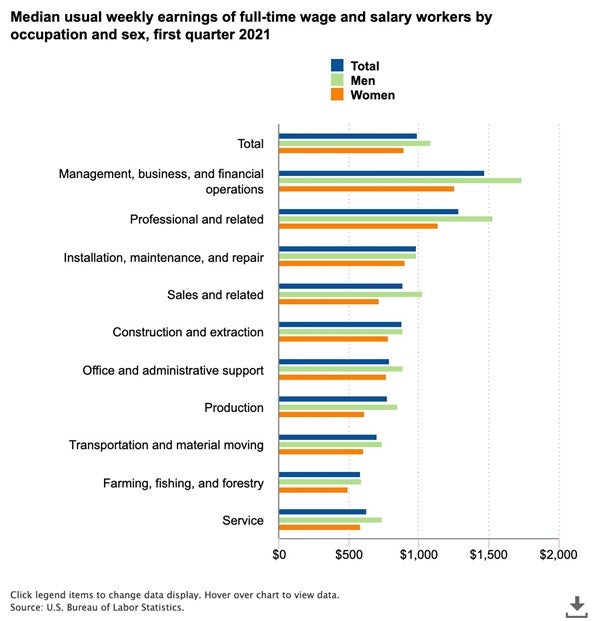Overcoming Gender Barriers and Gender Bias in the Workplace

In 2021, the number of women running Fortune 500 businesses hit an all-time record, with 41 women topping the annual list. For the first time in history, two Black women, Roz Brewer of Walgreens and Thasunda Brown Duckett of TIAA, are heading up organizations on the list. Another stand-out is CEO Karen Lynch, leading one of the highest-ranking businesses, CVS Health. It’s important to celebrate these accomplishments but also acknowledge there is much work still to be done on the gender equality front.
Gender barriers continue to impact careers and leadership opportunities for women. The next generation of leaders must prioritize gender parity by engaging in continuous education and action-based initiatives that combat gender barriers and gender bias in the workplace.
Gender and leadership representation is vital in a business setting and equally important when claiming positions of power in the government; women must have a say in policy-making decisions that directly impact the world around them. How can women overcome gender barriers to achieve equal representation? The conversation goes beyond women and must include men, women and non-binary individuals. The discussion about gender bias must also acknowledge intersectionality, defined as “the interconnected nature of social categorizations such as race, class, and gender as they apply to a given individual or group, regarded as creating overlapping and interdependent systems of discrimination or disadvantage.” People from all backgrounds and orientations deserve a seat at the table, and embracing differences starts with inclusive leadership.

What is Gender Bias?
Gender bias refers to the stereotypical beliefs that people have about individuals based on their sex, mainly related to the differential treatment of men and women. Stereotypes are present in mainstream media, conversational linguistics, marketing campaigns, family structures and other interactions that people encounter daily. As a result, people are not always aware of the implicit gender biases they carry. One’s level of awareness (or lack thereof) separates this phenomenon into two distinct categories: conscious and unconscious gender bias.
Conscious gender bias
Conscious gender bias refers to the awareness of one’s prejudices related to gendered differences. Conscious gender biases knowingly affect one’s decisions and behavior. For example, suppose an organizational leader promotes a man instead of a woman based on the belief that men are better leaders than women. In this case, the hiring leader displays conscious gender bias due to their awareness during the decision-making process.
Unconscious gender bias
Unconscious gender bias encompasses implicit gender biases that one does not believe, accept or act upon overtly. In the case of unconscious gender bias, an individual may consciously think one thing and unconsciously believe the opposite. For example, a leader may overtly think that women and men possess the same abilities to excel as leaders. However, the same leader may unconsciously regard men as better leaders. As a result, this leader may hire a man over a more qualified woman without understanding the unconscious drivers at play in the decision-making process.
How Gender Biases Lead to Gender Barriers With Dr. Kimberly DeSimone
In the Advancing Women Podcast, Gender Equity Expert and Executive Coach Dr. Kimberly DeSimone talks about a study she published on a Fortune 100 company. Dr. DeSimone, also St. Bonaventure University’s Master of Arts in Leadership program director, conducted a series of interviews with women who were identified as top talent with high advancement potential by their leadership team.
Unconscious internalized gender biases impact the mindset of women and consequently lead to genuine gender barriers that feel personal, but are in fact, societally imposed. In Dr. Kimberly DeSimone’s study, women frequently internalized professional barriers to advancement as personal or self-imposed. They talked about difficulties with work-life balance and the extreme expectations that come with advancement, but they still talked about this in the context of what they perceived to be self-imposed barriers. Women frequently reported that they wouldn’t be able to do what they needed for their family and in other areas of their lives if they were to take on those additional advancement roles.
“That mindset is where a shift is needed,” Dr. DeSimone says. “The barriers are real, and they’re problematic, but they are not women’s fault, they are not self-imposed barriers. There is a strong personal responsibility narrative to career advancement that is reinforced consistently in organizational messaging”.
Earlier this year, Dr. DeSimone hosted a talk for International Women’s Day surrounding this topic, titled “Women in leadership: more fixing the pipeline, less fixing the women.” In this talk, Dr. DeSimone addresses the underrepresentation of women at the highest leadership levels.
“A lot of programming has developed around the idea that women are broken, that we need to be fixed, and that if we could fix women and get them to where they need to be, then of course they could fix the problem for themselves,” says Dr. DeSimone. “This is positioned as an individual problem for women, when this is really a larger societal and structural issue that has deeply entrenched roots.”
This talk underscores how widespread internal gender biases manifest as gender barriers at all levels, particularly at higher levels of leadership. Gender equality is not a woman’s problem; it’s everyone’s responsibility to champion women in leadership until we reach a stage of “normalization,” when seeing female representation is no longer unconventional.
Organizations can tackle these gender barriers by implementing more effective models that enable two partners in a home with dependent children to advance and all employees, even top leaders, to have a healthy work-life balance.
Statistics about Gender Bias and Gender Barriers in the Workplace
As a society, we are slowly progressing toward a world of gender parity by gradually removing gender barriers. Workplaces are funding gender bias training, the proportion of women in senior management roles grew to 29% globally (the highest number ever recorded in 2019), and women’s representation improved across all levels of the corporate pipeline in 2020.
Despite the strides we’re making toward equality, statistics reveal shocking truths about worldwide gender bias and gender barriers that continue to impact women at work. For example, a 2020 UN report found that nearly 90% of men and women hold biases against females.
According to the study, close to 50% of men believe they have more right to a job than women. The study also found that organizations pay women less than men in the global labor market. In addition, women are much less likely to be in senior positions than men, and 40% thought men made better business executives than women.
Although women are well represented as middle managers, the numbers drop off when making the jump to VP-level executives. The statistics are especially concerning when it comes to intersectionality in the workplace. According to McKinsey & Company, “representation of women of color falls off relative to White men, White women, and men of color at every step in the corporate pipeline, leaving them severely underrepresented at the top.”

The Gender Pay Gap in America
Gender bias in the workplace is evident in the gender pay gap that continues to impact women worldwide. According to Pew Research Center, the gender pay gap has remained stable in the United States for 15 years. Research also finds that the pay gap persisted in 2020 when women reportedly earned 84% of what men received. In addition, an analysis of median hourly earnings from 2020 estimates that it would take an extra 42 days of work for women to make the equivalent of men. The U.S. Bureau of Labor Statistics chart below reveals that the gender pay gap in America spans all industries and shows the most significant disparity in the management, business, and financial operations sectors.

Common Types of Gender Barriers and Gender Bias in the Workplace
There are several common types of gender bias in the workplace that negatively impact women, from hiring and salary options to firing and benefits. A few common examples of gender bias in the workplace can look like:
- Male candidates are preferentially hired over female candidates with equivalent experience.
- Women who are recent or soon-to-be mothers are passed over for high-profile promotions.
- Ideas advanced by men are given more attention than ideas advanced by women.
- Women are unfairly assigned inferior accounts compared to men and, as a result, earn lower performance-based commissions.
- Pregnant or nursing women are fired from their jobs while taking time off.
- Men are more likely to enter leadership positions, especially at the highest levels.
Various studies have empirically demonstrated that gender bias is a real and pervasive issue. For example, in one study, researchers replaced a stereotypical woman’s name with a man’s name on a resume. They found that companies were 60% more likely to hire applicants with the stereotypical man’s name. This instance highlights that a male candidate has an advantage over a female applicant simply for being male, regardless of their qualifications.
In another study, researchers tested whether hiring evaluators carried gender bias based on a woman’s parental responsibilities. The study compared identical resumes with one differentiating factor — one version featured “Parent-Teacher Association Coordinator” to signify that the female applicant is a parent. The women who identified as mothers were 76% less likely to be hired, and if the evaluator hired them, they would be offered $11,000 less on average than the other applicants.
These external gender barriers in the workplace impact a woman’s confidence and comfort level on the job. In a recent experiment, researchers had men and women rank their performance on a test. Participants were told that one of the self-promotional questions would be the sole basis for employers to decide who would be hired and what salary would be offered. Women consistently rated their performance lower than men, despite their actual performance being the same.
In the Advancing Women Podcast, Dr. Kimberly DeSimone explores the typical scenario of men and women applying for roles they aren’t fully qualified for. “Women must prove their competence and ability over and over again, much more than their male counterparts, and the research shows that men are often hired or promoted for potential,” says Dr. DeSimone. “Women are not afforded that same benefit of the doubt. So, yes, it’s fear, but logical and well-founded.”
Leaders and hiring managers must support women and as Reshma Saujani, the founder of Girls Who Code, famously said, “teach women to be brave, not perfect.” Women must be brave when facing gender barriers in the workplace and continue to show up to enact real change.
Ways to Reduce Gender Bias and Gender Barriers
Overcoming gender barriers and reducing gender bias in the workplace goes beyond knowledge. Knowing is not enough — leaders must spearhead company-wide solutions, track progress and review data to identify tangible change. Some organizations provide training programs designed to remove gender barriers.
For example, the organization Lean In launched a digital program called 50 Ways to Combat Gender Bias. The program uses workshops, group activities and other training initiatives to empower all employees to identify and challenge gender bias in the workplace head-on.
Does gender bias training work? Research has shown that corporate diversity and sensitivity training doesn’t always work. BBC says, “quick training ‘hits’ don’t change long-term behaviors and biases, research shows, and may even reinforce stereotypes.” Effectively, gender bias training must be company-wide, long-term and reviewed annually. To enact meaningful organizational change, leaders must go beyond “quick hit” training sessions and apply a multipronged approach that includes:
- Recruitment strategies that address gender diversity
- Human resources training in gender diversity
- Mentorship programs for women
- Annual training programs and diversity initiatives
- Organizational goal-setting to meet gender representation objectives
- Access to education and learning opportunities for women

Overcome Gender Barriers with an Online Master of Arts in Leadership
Tomorrow’s leaders learn from today’s future-focused programs. St. Bonaventure University’s online Master of Arts in Leadership will prepare you to lead in any business climate with a solid foundation of leadership skills in communication, strategic thinking, change management, innovation and team-building.
St. Bonaventure values gender equality and encourages leaders to be advocates for equity, diversity and inclusion in the workplace. The online Master of Arts in Leadership teaches the next generation of leaders to make decisions rooted in compassion, humanity, ethics, and integrity and aim towards positive social change.
- Make an Impact — Immediately apply your growing leadership skills in organizational dynamics, mentorship, remote and global work environments, and more.
- Communicate and Empower — Master the art of impactful communication to create genuine relationships, foster clarity, and trust, and empower staff.
- Grow Personally and Professionally — Hone your personal ethics code and motivations as a leader to think and operate on a completely different level, transitioning from individual contributor or manager to a highly-skilled, compassionate leader.
Graduates of our online Master of Arts in Leadership program not only become strong managers but true servant leaders who can think strategically, empower and inspire others to fulfill their potential, and communicate with eloquence and confidence.
Learn the leadership skills you need to inspire change and advocate for others with an online Master of Arts in Leadership from St. Bonaventure University.
